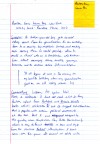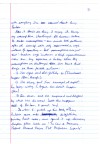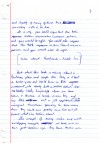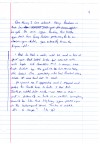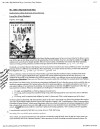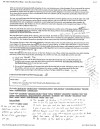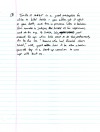For some time now, I have wanted to do a blog post about my writing process for the reviews I do here, in an attempt to demystify my writing process for my students.
I want to be very clear about one important thing up front: writing for this blog is very different that some of the other types of writing that I do. If you venture over to my curriculum vitae, I’ve posted some of the papers I’ve written for various English classes. This academic writing is very different from the sort of writing I’m doing here.
To start with, for those pieces I usually take each piece through at least seven or eight drafts, and many of them, especially the ones I’ve posted on my CV, have gone through as many as 15 drafts. That sort of writing rather requires a lot of drafts, because:
- I’m doing research as I’m writing, so I’m constantly incorporating new research into what I’m writing, and
- I’m also playing around with the order of paragraphs, so that the piece flows and makes sense, and
- I’m trying to eliminate as many typos as possible.
For these blog pieces, however, there’s no need to take them through so many drafts. Blog drafts are meant to be more off-the-cuff, more conversational. They also aren’t nearly as long, so I find that three drafts at most are needed in most cases.
What I’ve done here is to take the drafts of a recent post, my review of Lawn Boy by Gary Paulsen, scan them, and post them here with some commentary.
The First Draft
Here are thumbnails of the first draft. (Clicking on each one will open the full-sized image in a separate window.) A lot of people call this the “rough draft,” but really, the terms are interchangeable. No writer gets it right the first time, so every first draft is a rough draft. And because no writer ever gets it perfect either, every draft that follows is really just a “less rough draft.”
The first thing to notice is that it’s written on ordinary notebook paper. That means I wrote it at home, because if I’m in class or at the library, I use a spiral-bound notebook so I don’t lose pages. This draft also has a yellow sticky note attached to the first page, because first drafts get stapled together and go into my 3-ring blog draft notebook, and the sticky note helps me find it later.
I use a writing notebook to hang onto first drafts until I get a chance to revise them, which can be anywhere from a few days to a few weeks later. In general, I don’t like to write a first draft and then revise it right away, because I’m still in the same frame of mind that I was when I first wrote it, and it’s really difficult to revise something that is still so fresh. I find that I need to put some temporal distance between the first draft and myself before I can revise it effectively. How long this takes depends partly on the length of my first draft (the longer the draft, the longer I wait to revise it) but also on how strongly I feel about the book I’m reviewing. The more I like it—or the more I detest it—the longer I need before I can revise with even the barest hint of objectivity.
That is really what I’m striving for in the second draft—a degree of objectivity. If I really like a book, or really don’t like it, and I’m trying to convince others of that opinion, I can’t just say that I like it and that’s good enough. I need to talk about what it is I find so compelling, or so week, and lay my evidence out for others to see. I need to appeal to their logic at least as much as I appeal to their emotion.
Anyway, some drafts do take a bit longer to get around to—months rather than weeks. On average, I would say that the time between the first draft and the second draft is about three weeks, but that is only an average, and probably a highly inaccurate one at that. In the case of Lawn Boy, a book which I quite enjoyed, there was at most a week between the first draft and the second. Could I have waited longer? Sure. Would that have made my second draft stronger? Possibly. Probably, even. What pushed me to get to get to work on that second draft was how delighted I was by the book and my eagerness to talk about it.
I generally write the first draft the same day I finish a book (ideally), but I also start reading a new book the next day as well. I wanted to get this review done before I got too emotionally involved with another book. As for that objectivity I’m striving for? Well, I had a visceral response to the book before I read it, and found that I was wrong about it, and found that I could approach it more intellectually than I thought. So yes, I was able to approach it sooner than I thought.
Even though I don’t really have rules for writing on this blog, I try to stick by the “three weeks between drafts” guideline. This isn’t always possible, of course. If you’re in a middle school or high school or college English class, you probably have tighter deadlines than these, and don’t have the luxury of allowing a piece to rest for three weeks between drafts. In such classes, the emphasis is often on the quantity of your writing, rather than the quality, the belief being that the more you write the better you will get at it. (To be certain, there are careers—such as journalism—where you are expected to produce finished pieces every day, or every week, or every month.) If you are in such a class, and struggling with getting pieces polished the way you would like, you might approach your instructor with the suggestion that you would really benefit from taking one of your pieces and expanding it and playing around with it longer than usual. The worst they can do is say no.
I started my draft with the citation information, in MLA format. I expect my students to follow this convention, and I want these posts to serve as an example. At the bottom of every post there is a “Works Cited” section, which lists the book I am reviewing along with any other books I mention. The problem is that I don’t own many of the books I review here—most of them I get from the library. So I make sure to capture that all-too-important citation information while I still have the book in my hand.
One other thing to note in this first draft is that I’m already trying to follow the conventions of my own blog. Because direct quotations on this blog show up as indented paragraphs with a shaded background, when I make a direct quote in my first draft, I indent it and draw line along the left-hand side, so I know that this is a direct quote. I am also trying to stick to my own conventions by writing a synopis and then my commentary. (Although this convention is not firmly established here yet.)
While I try to be organized in this first draft, I’m not too worried about organization. Organization can always come later and thanks to technology, it is also a lot easier. By organization I mean that the paragraphs come in an order that makes sense, that readers’ mind aren’t abruptly jarred when they go from paragraph to another. This is sometimes hard to achieve, but that’s what subsequent drafts are all about. My main goal in this first draft is to get as many ideas about this book out of my head and onto paper as possible.
Will I get all my ideas down on paper? Nope, because some these ideas came about as a result of writing the first draft, and some as a result of revising the first draft. Will I use all my ideas in my final draft. Again, the answer is no, because some of my ideas are silly, and some are just plain stupid, and a lot of them are merely repetitive. Sometimes I know what I want to say, but I’m so busy writing that my mind can’t figure out exactly how I want to say it, and I end up saying it a number of times in a number of different ways before I finally arrive at the a final sublime phrasing. I just have to remember to go back and take out all those times I didn’t get it right.
This is perfectly okay.
It’s a part of the writing process, and a part of any creative process. Sometimes we merely need to flush the lines before we can get to what we want to say. I do this all the time. The more conflicted I am about a topic, the more I write about it before I write something I know is good. Writing is really thinking on paper. Sometimes my thoughts on a topic are really clear, and whether I take a piece through three drafts or thirteen drafts, 90% of that first draft ends up—in one form or another—in my final draft. Other times, I’m really conflicted about a topic, and maybe only 10% of that first draft makes it into that final draft. In such cases, I definitely go through more than three drafts.
The Second Draft
As before, we start with thumbnails. And again, clicking on each one will open the full-sized image in a separate window.
I don’t save every draft of everything I write or I would be buried under a sea of paper. Because this is a blog entry, I wrote six pages longhand and probably used 80% of what was there. Other times, I use only 50%; in a few instances (generally with the shorter posts) about 90-95% of that first draft ends up in the final post.
Also, because this is a blog entry, and thus is entirely my own opinion, I just go at it when I write a first draft, just trying to set everything down on paper without getting too off-topic or getting too caught up in spelling or punctuation. Most of the crossing-outs you see in my first drafts are words I spelled incorrectly.
Were I doing more serious academic writing (a term paper, say) I might start with an outline, either on paper or in my head, and start writing with that outline firmly in my mind, although as I made discoveries through my writing, I would be willing to change my outline based on what I discovered. This is not unlike writing fiction or poetry.
To create the second draft, I start typing on the computer. When I’ve finished, I print it out, and then make notes.
The first thing you’ll notice is that if you look carefully, what is printed on the page does not exactly match my first draft, because as I type into the computer, I inevitably change things. This doesn’t matter whether I’m writing for this blog or for a class. I prefer to write first drafts longhand. Because I inevitably make changes to my manuscript as I transcribe it, this means that the very act of transcription is in itself an editorial process.
Again, this is okay—so long as we recognize it as such. Otherwise, changes may appear in our manuscript of which we are not aware. I don’t let myself get too carried away, because I don’t want to ramble off in an unrelated direction. (Although sometimes I do because I realize that this is the direction I should have been going in the first place, or that this rambling is the basis for a new blog post.)
To get to that next draft, I print out what I have and take a look at it. At this point, I’m interested in three things:
- Does my writing naturally flow from one point to the next, or are there points at which I stand to confuse readers by jumping too quickly from one idea to another?
- Have I backed up my assertions with evidence? Even though this is a blog and therefore is my opinion, I still need evidence. If I say that the voice is wonky or that the metaphors are confusing, I need to include examples that help me make my point.
- Are there spelling, punctuation, or other mechanical issues that need to be corrected? Ordinarily, I would not worry about these issues until further down the line, but because I am only writing three drafts at most (and I don’t have a peer-editor to look at my work), I need to start looking at these things as quickly as possible.
Some other things to notice:
- Sometimes I leave things out which I later need to fill in.
- Sometimes I make alterations in pencil and sometimes in ink. This means that I went back to this draft more than once. That’s fine—there’s no rule that says you can only revisit a draft once. In fact, it’s sometimes useful to revisit a draft several times, at different times of the day or on different days of the week.
- I make comments in the margins, either about content or about format.
- I insert extra text with a caret (^), when there is space. When there isn’t, I just write a number and circle it where I need to insert the extra text. Then I write the new stuff on a blank sheet of paper, keyed with the same circled number.
The most important part of this second draft is to fill in any gaps in my arguments and to avoid redundancies, because in earlier drafts, I have a tendency to say the same thing in different versions until I finally get around to saying what I want to say the way I really want to say it.
Caveat: There really is no such thing as a finished manuscript. In fact, a famous writer (and for the life of me, I can’t remember who) said that there are really only abandoned manuscripts. So while I’ve said that what you’ll see on this blog are third drafts, that’s not always the case. I can always go back and edit a post, and often do when I find a typo. But once a piece is published, I don’t alter the content in any way. That’s why I keep the comments open forever, because that’s where I’ll change my mind, if necessary.
One last note:
I actually started this post shortly after I wrote the review, and worked on it through the month of August. It’s not until now that I actually got around to finishing it up and publishing it. In the meantime, I cleaned up the scans of my drafts. They’re big files because they’re scanned for print at 300 dpi, but you can print them out and they be legible enough you can see what I’m talking about.
https://bookblog.kjodle.net/2011/02/10/some-notes-on-my-writing-process/
